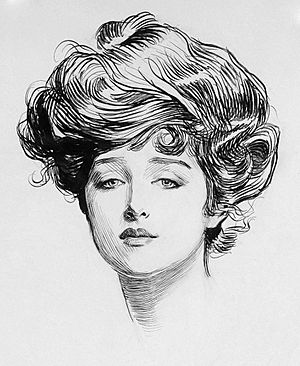Gibson Girl facts for kids

The Gibson Girl was a popular image of the perfect young woman in the United States. This image was created by artist Charles Dana Gibson through his pen-and-ink drawings. She was famous for about 20 years, from the late 1800s to the early 1900s. Gibson believed his drawings showed what thousands of American girls were like.
Contents
What Did the Gibson Girl Look Like?
The Gibson Girl image became popular in the 1890s. She combined different ideas of beauty from that time. She was tall and slender, but also had a full chest and hips. Her body had an "S" shape because of the corset she wore. This look showed how people in the late 1800s and early 1900s loved youthful beauty.
Her neck was thin, and her hair was piled high on her head. Popular hairstyles included the bouffant, pompadour, and chignon (a "waterfall of curls"). The Gibson Girl always looked stylish and comfortable.
Her Style and Personality

The Gibson Girl was usually shown as a member of the upper middle class. She always wore the latest fashion, perfect for the time and place. She was also seen as a new, more active woman. You might find her riding a bicycle in Central Park or exercising. She was also independent enough to work outside the home.
Besides her beauty, the Gibson Girl was calm, confident, and independent. She wanted to achieve her own goals. She could be shown attending college or looking for a good partner. However, she was never shown taking part in the women's suffrage movement, which was about women getting the right to vote.
Gibson Girl vs. The New Woman
Around the same time, another image of women appeared called the "New Woman." The New Woman was more focused on social and political changes. She wanted equal education, work opportunities, and the right to vote. The Gibson Girl shared some traits with the New Woman, like being independent. However, she avoided politics. This made her seem less challenging to traditional ideas about women.
Gibson often drew the Gibson Girl as an equal to men, or even playfully teasing them. Sometimes, men looked silly or clumsy next to her beauty. Men were often shown to be so charmed by her that they would do anything she asked. One drawing shows men planting a tree upside-down just because she wanted it that way!
Most often, the Gibson Girl was shown as single and free. But a romance always made her happy. If she was married, she might be frustrated if the romance was gone. But she was happy when socializing with friends or caring for her baby. These drawings usually showed her in traditional women's roles.
What Charles Dana Gibson Said
The artist, Charles Dana Gibson, believed the Gibson Girl showed the beauty of American women. He once said:
I saw her on the streets, I saw her at the theatres, I saw her in the churches. I saw her everywhere and doing everything. I saw her idling on Fifth Avenue and at work behind the counters of the stores ... I haven't really created a distinctive type, the nation made the type. ... There isn't any 'Gibson Girl,' but there are many thousands of American girls, and for that let us all thank God.
Gibson also thought American women would become even more beautiful in the future. He believed this was because of the mix of different cultures in the United States.
Who Modeled for the Gibson Girl?
Many women posed for Gibson Girl drawings. Gibson's own wife, Irene Langhorne, might have been the first model. Other models included Mabel Normand, Evelyn Nesbit, and Clara B. Fayette. The most famous Gibson Girl was probably the actress Camille Clifford. Her tall hair and elegant, tight-waisted dresses perfectly showed the style.
Other artists also drew women in the Gibson Girl style. These included Howard Chandler Christy and Harry G. Peter, who later became famous for drawing Wonder Woman comics. In early movies, actresses like Florence Lawrence and Mary Pickford also helped make the "ideal woman" popular around the world.
Why Was She So Popular?
Some people say the Gibson Girl was the first national beauty standard for American women. Her pictures in newspapers and magazines were very popular. You could find her image on many items like plates, ashtrays, tablecloths, and souvenir spoons.
However, after World War I started, fashion changed. Women began to prefer practical clothes over the elegant dresses and long skirts of the Gibson Girl. So, the Gibson Girl style became less popular.
Even so, the image was not completely forgotten. During World War II, a survival radio used by aircraft was nicknamed "Gibson Girl." This was because its "hourglass" shape looked like the Gibson Girl's figure.
See also
- It girl
- Flapper
- Nell Brinkley
- Pompadour haircut
- Evelyn Nesbit





